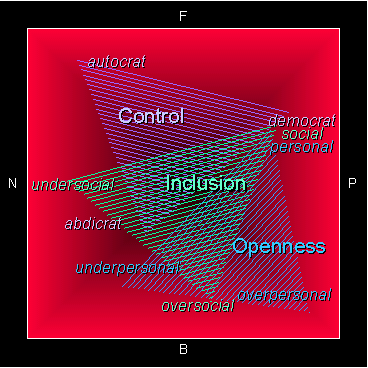|
SYMLOG
and
FIRO
|
|||||||||||||||||||||||||||||||||||||||||||||||||||||||||||||||||||||||||||||||||||||||||
Overview of FIRO-B
Will Schutz presented FIRO theory, and the classic
measuring instrument FIRO-B (now Element B), to social psychology in
1958.
FIRO describes interpersonal behavior in terms of three primary dimensions:
These dimensions are fundamental to all human social organisms, whether
an infant in the early stages of child development, small groups,
or organizations.
FIRO-B measures these three dimensions from two perspectives:
The optimum fit between two people (two social organisms, e.g., 1
and 2) would require six matches:
Of interest to organizational consultants is FIRO's contribution to understanding human behavior. Some combinations of the three primary needs produce compatibility and others incompatibility. Groups characterized by high compatibility among members' preferences are likely to be more content, productive, and efficient. Underlying FIRO is the assumption that preferences, as well as behavior, can be changed (at will). Thus FIRO is not a theory of inherent, immutable personality traits. Rather, it provides material for development efforts. How FIRO Relates to SYMLOG
Field Theory
Like SYMLOG assessments, FIRO is based on the assumption that there
is a universe of behaviors that are neither irrefutably good nor irrefutably
bad. SYMLOG also takes into account the situation. FIRO disregards
this and says that it measures "personal preference." The focus is
"key relationships," although such key relationships could indeed
part of a given situation.
FIRO-B measures an individual's self-report of comfort level with
degrees of expression of the three interpersonal dimensions. This
assessment of "preferred" behavior should probably be distinguished
from the SYMLOG concepts of Wish and Ideal, both of which are idealized
images and do not measure the "comfort" level (or judgment about satisficing)
that FIRO does. Because SYMLOG can be used to collect data from others
(peers, clients, subordinates) about a wide variety of psycho-social
phenomena, it is more complex and robust than FIRO.
The primary characterizations of the three FIRO needs, as described
by Shutz, may be coded using SYMLOG, as illustrated in the following
table. Shutz describes a resolution, or optimum balance, for each
need and the two extremes of the continuum as well.
Openness seems to address the content of communication, rather than
the dynamics of communication. Openness may be considered an expression
of content about personal life that has little to do with the task,
and thus it is suggested that behavior about personal content is likely
associated with the B part of the space.
What FIRO emphasizes, which SYMLOG does not, is a unilinear theory
of development (group process). There is a specific sequence to the
addressing of needs in positive relationship building:
Inclusion should come first, before issues related
to Control and Affection can be successfully addressed. Control issues
must be resolved before those of Affection.
Group process, as represented by SYMLOG is not unilinear, but resembles
a dialectic, as polarizations give way to new unifications, which
in turn produce new polarizations. These may occur at different social
levels and with secondary as well as primary value conflicts as their
foci. Although the classic SYMLOG polarization is the PF-NB polarization,
and secondary to this is the NF-PB polarization, the field is subject
to pushes and pulls from all directions. |
 Plot in SYMLOG Space of FIRO-B
|
||||||||||||||||||||||||||||||||||||||||||||||||||||||||||||||||||||||||||||||||||||||||
Musselwhite, E. (1982). FIRO B. Palo
Alto, CA: Consulting Psychologists Press.
Schutz, W. (1958). FIRO: A three-dimensional theory of interpersonal
behavior. New York: Holt, Rinehart & Winston.
Schutz, W. (1966). The interpersonal underworld (FIRO) [originally
published 1958]
Schutz, W. (1988). Profound simplicity. Muir Beach, CA:
Will Schutz Associates. |
|||||||||||||||||||||||||||||||||||||||||||||||||||||||||||||||||||||||||||||||||||||||||